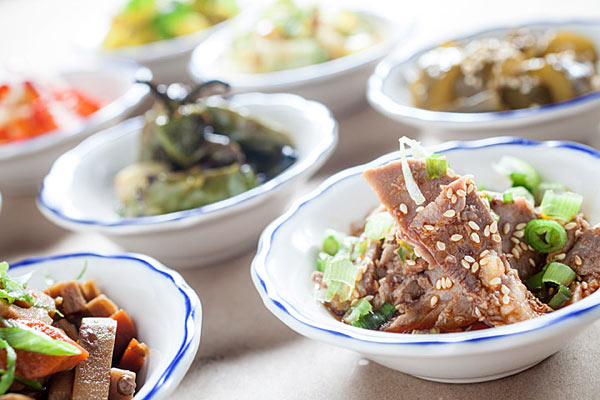
Photograph: Hugo Galdones/Courtesy of Fat Rice
These are great days to be a diner. You can walk into a storefront in a gentrifying neighborhood and get an African-inspired dish that’s served primarily in a former Portuguese colony near Hong Kong; five years ago, you would’ve gotten a blueberry muffin. Such is life in Logan Square, where Fat Rice plies fascinating East-West creations for a crowd so hungry for adventure that it’s willing to wait an hour without reservations on a Wednesday night.
Abraham Conlon and Adrienne Lo, Fat Rice’s partners, are not culinary tourists pillaging a random far-off land. The pair—one Portuguese, the other Chinese—traveled 7,400 miles to China, then made a side trip to Macau to learn its storied food culture. They found that traditional Macanese food, which evolved over 400 years of Portuguese occupation in the Far East and fuses influences from places as disparate as India, Brazil, Malaysia, and Angola, was dying. “People told us, ‘If you want to learn about it, talk to people in the retirement home,’ ” says Conlon.
Instead, they went to Riquexo Cafe in the Macau Peninsula, where the 94-year-old chef Dona Aida de Jesus reminisced and cooked for them. Portuguese chicken in coconut curry (po kok gai), a stew of pig’s ears (feijoada), a duck cooked in its own blood (pato de cabidela): The experience changed everything for the duo.
THE SKINNY
FAT RICE 2957 W. Diversey
Ave., 773-661-9170
FYI The new lunch menu includes a soon-to-be-legendary Macanese pork chop bun.
TAB $20 to $30
HOURS Dinner Tue. to Sun.
Tab does not include alcohol, tax, or tip.
Fat Rice uses that meal as its launching pad, but even those unfamiliar with the spot’s link to history will find plenty to love. The pepper-stoked flamin’ fish head curry with okra and tomato and the Goan cauliflower curry with pumpkin, long bean, zucchini, and tomato honor Macau’s potent-homey melting-pot approach. You’ve got unfussy but terrific hand-rolled chee cheong fun noodles with mushrooms and scrambled eggs, traditional options such as Balichang catfish, and prospects so spicy—soft Sichuan-style bacon with bamboo, leeks, wood ear, and those notorious Sichuan peppercorns—that they leave your tongue punch-drunk.
Fat Rice’s pot stickers, steamed in a pan lined with batter to provide a crispy base, are already famous. The batter becomes a thin curtain beneath which you find brilliant dumplings stuffed with Lo’s family recipe: pork, shrimp, European cabbage, and chives. Almost as satisfying is the tender piri-piri chicken, half a bird with a thick Goan coconut-tomato curry sauce thickened with peanuts. The pickled snacks, such as sour chili cabbage, are curiously untingly, though I respect anyone who serves pickled jellyfish cheeks.
The centerpiece is the unforgettable, paella-like arroz gordo, a giant pot swimming with garlic-and-sofrito-scented rice that includes disks of Chinese sausage and duck, slabs of linguiça, a king’s ransom of roasted Portuguese chicken, littleneck clams, grilled prawns, a tea egg, and pickled raisins. “This dish incorporates all the ideals we want to convey,” says Conlon. “And it’s a great signature.” Especially when you get to the bottom, where the rice has crisped à la bibimbap.
The limited dessert menu includes one inspired creation: a marshmallowy Macau crisp. Adapted from a fried-dough Asian snack, it’s topped with pork floss (fluffy braised and dried pork), nori, and sesame—a brown Rice Krispies treat by way of farm and sea.
Fat Rice’s tiny corner space, which previously housed a bakeshop, a sandwich joint, a tavern, and a taqueria, is now done up in typical Logan Square style: communal tables, bar facing an open kitchen, shelves lined with rustic plates. Servers mean well, but they’re outmatched in the congested room. With the kitchen rocking all night and the bar banging out drinks nonstop—such as the Kalimotxo, a strangely alluring Coke-rioja-lemon brew—there’s little room for error.
Fat Rice’s goal—“to showcase the traditions of Macanese cuisine, as well as present our own take,” says Conlon—is loftier than at the average neighborhood haunt, and it’s worth supporting. When a business keeps a dying culture alive, mistakes have a way of not mattering.



